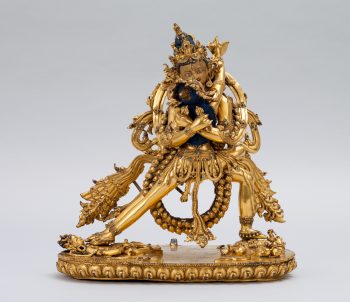Central Tibet
14th century
This gesture is that of embracing a consort and is symbolic of bringing together two aspects of enlightenment: wisdom and method.
Central Tibet
14th century





Chakrasamvara is the primary meditation deity (yidam) of the various Kagyu Schools of Tibetan Buddhism and is also prominently featured in a number of other traditions. He and his consort Vajravarahi trample on the deities Bhairava and Kalaratri (see detail), the wrathful manifestations of the divine couple Shiva and Parvati, subjugating them. Hindu deities are often incorporated into Buddhist iconography, sometimes in positive roles and other times as representative of obstacles to be overcome, an expression of both common cultural roots and the tension between the two competing traditions.This magnificent bronze sculpture has many delicate details. The figures are slender with long limbs whose movement is echoed by rippling scarves and flaring jewel strands. Only a master artist could have achieved such a natural union of fine detail, iconographic accuracy, and aesthetic appeal. This elegant bronze demonstrates the continuing importance of Nepalese craftsmanship in Tibet.
A religious movement that originated in India around the fifth to seventh century with sacred writings and esoteric teachings and practices transmitted from teacher to student through initiation. These remain an important part of Hinduism and Buddhism today.
A contemplative practice in which a person uses concentration and visualization to achieve aims such as transforming the mind and generating feelings of compassion. Techniques include focusing on breathing or visualizing oneself as a deity.
Tantric deities personify various enlightened qualities and are the focus of esoteric religious practices (tantras) that aim to swiftly and radically transform one’s understanding of reality.
Today, Tibetans primarily inhabit the Tibetan Plateau, situated between the Himalayan mountain range and the Indian subcontinent to the west, Chinese cultural regions to the east, and Mongolian cultural regions to the northeast. During the 7th to 9th century, Tibetan rulers expanded their empire across Central Asia, and established Buddhism as the state religion.
Get the latest news and stories from the Rubin, plus occasional information on how to support our work.